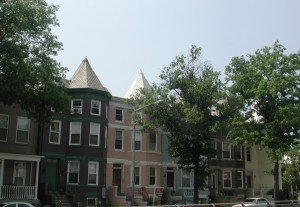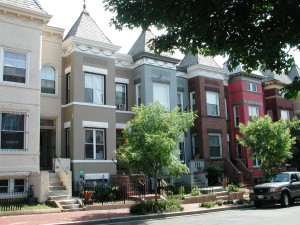 The row-house flat was a dwelling type new to Washington in the early years of the twentieth century. It had been introduced in 1897 by the Washington Sanitary Improvement Company, which wasfounded that year. A year earlier, the Washington Central Relief Committee had concluded that no class of realty paid as well as alley dwellings and that, during such a severe housing shortage, developers could profit from the construction of sanitary and comfortable houses for the blue-collar worker. The row-house flat was the solution. From the exterior, the two-unit building appeared to be a single-family residence, avoiding the stigma associated, at that time, with living in a multi-family dwelling. Once inside the foyer, the occupants were provided private entrances to the individual units.
The row-house flat was a dwelling type new to Washington in the early years of the twentieth century. It had been introduced in 1897 by the Washington Sanitary Improvement Company, which wasfounded that year. A year earlier, the Washington Central Relief Committee had concluded that no class of realty paid as well as alley dwellings and that, during such a severe housing shortage, developers could profit from the construction of sanitary and comfortable houses for the blue-collar worker. The row-house flat was the solution. From the exterior, the two-unit building appeared to be a single-family residence, avoiding the stigma associated, at that time, with living in a multi-family dwelling. Once inside the foyer, the occupants were provided private entrances to the individual units.
 As early as 1900, Wardman was constructing row-house flats in older areas of the city, building them for other developers as well as acting as developer in his own right. In 1903, he began building them In Bloomingdale, first in partnership with Harry Willson at 35-43 Quincy Street, NW; then as both builder and developer at 20-34 Seaton Street and 14-30 T Street, NE; and partnering in 1904 with David Moore at 2026-2034 North Capitol Street, NW. By 1905, Wardman had abandoned the row-house flat. It was a short-lived phenomenon in Washington, replaced after only a few years by the larger, more profitable apartment building.
As early as 1900, Wardman was constructing row-house flats in older areas of the city, building them for other developers as well as acting as developer in his own right. In 1903, he began building them In Bloomingdale, first in partnership with Harry Willson at 35-43 Quincy Street, NW; then as both builder and developer at 20-34 Seaton Street and 14-30 T Street, NE; and partnering in 1904 with David Moore at 2026-2034 North Capitol Street, NW. By 1905, Wardman had abandoned the row-house flat. It was a short-lived phenomenon in Washington, replaced after only a few years by the larger, more profitable apartment building.
